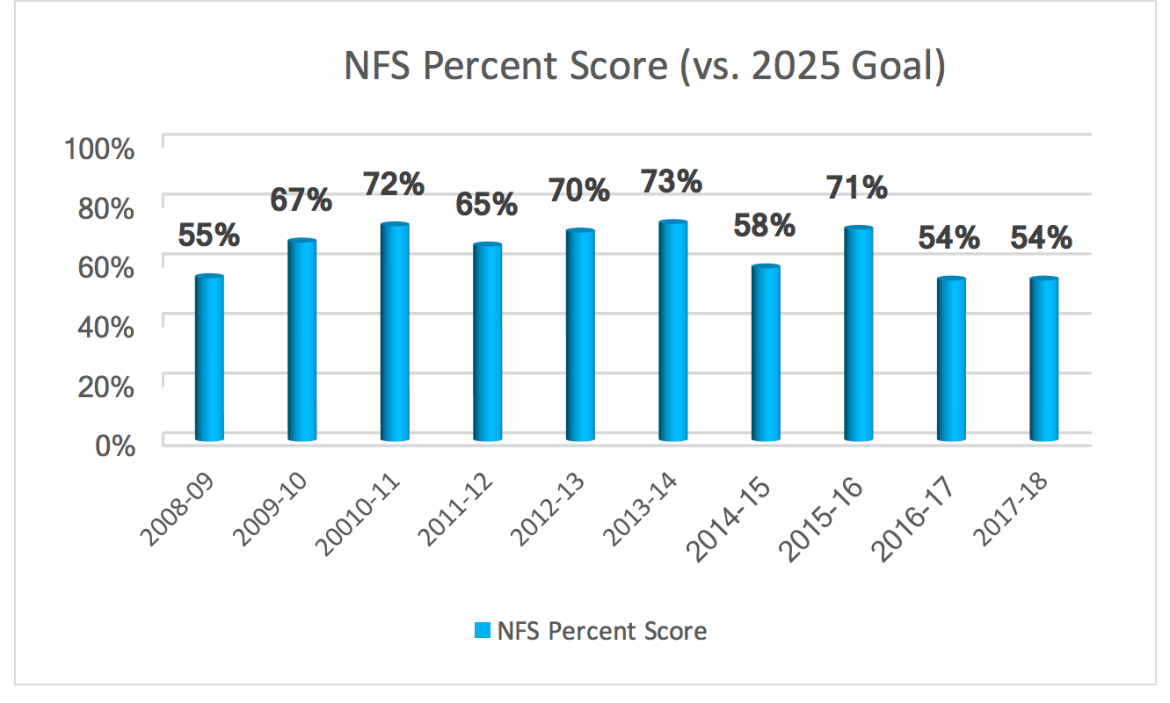Introducing…
The STC National Flu Score™ (NFS)
By Bill Davenhall, Mike Popovich & Dr. Scott Hamstra
We shoot!
We score! …Sometimes.
Did we WIN? Do we know?
In our battle with influenza we face a tricky foe, and lots of folks do lots and lots of work to fight it. Some years seem better than others, but how can we get a more objective view of what we can do to improve? …And to win the game?
We thought it useful and educational to create a Seasonal Flu Scorecard, one we could use to rank states, communities, health plans, retail pharmacies, and clinical networks. It would also create an index to measure what is changing in the adult and child seasonal flu programs across the United States, and to help us understand what is impacting improvements. Based on the reports generated by the CDC each year we constructed a STC National Flu Score™ or NFS.
Since there are three critical factors that reduce the impact of influenza on the population, we combined Estimated Child Coverage Rate, Estimated Adult Coverage Rate, and Estimated Vaccine Effectiveness Rate to establish a goal for the National Flu Scores™.
Looking back over the past decade, we used CDC published data to calculate an annual NFS (with 300 being the maximum attainable). The highest National Score (153) was for the 2013-2014 season, while the lowest score (115) was in 2008-2009. As of June 2018 we are still awaiting the final numbers for the most recent year (2017-2018)
In order to make these raw scores more meaningful it would be helpful to establish the definition of success and a method to measure success. Dr. Scott Hamstra, STC’s Medical Director states, “To achieve 100% across each of the TRIAD components is neither necessary or desirable, let alone attainable. Rather, the goal is ‘enough.’ Influenza is a tricky virus that ‘shifts’ each year and the brightest and best scientists on earth have been able to exceed 50% vaccine effectiveness just three times in the past 10 years. The last four years have all been below 50%. The second and third components of the STC NFS are the coverage rates, or the percent of the adult and children populations that receives their annual flu shot.” These three mesh together to protect our country against the flu.
From this data, Dr. Hamstra reasoned that a triad NFS target would be a score of 210 and established this as the goal to achieve by 2025.
Using this 2025 goal and looking back over the past decade, we see these results:

Converting these to letter grades is a meaningful way to show past performance and how much remains to be done. Our scores are not stellar . . .
Four C’s = 73%, 72%, 71% and 70%
Two D’s = 67% and 65%
and four F’s below 60 = 58%, 55%, and 54% x 2
Over the course of this year we will begin to explore the power of this NFS by examining detailed data found in statewide immunization registries, as well as begin to evaluate the NFS by community, demographics, regions, health plan member populations, and a variety of other meaningful categories to monitor the effectiveness of future public health influenza programs.
Pharmacy Camp
By Dale Dauten
“A few of us always compared anything good to: ‘ Isn’t it just like camp?’
When we first got married, we asked each other,
‘Was your honeymoon good?’
‘Yeah. It was just like camp.”
Laurie Kahn
 I don’t know about you, but when I think of summer camp, I think of lakes, bunk beds in old wooden cabins and ghost stories. Well… and mosquitos, sunburns, snakes and that relentlessly upbeat camp counselor who thought he was hilarious. What I don’t think of is disease prevention, or smartphone technology, coding, or immunization registries. But that was before the University of Arizona brought its Pharmacy Camp to STC headquarters.
I don’t know about you, but when I think of summer camp, I think of lakes, bunk beds in old wooden cabins and ghost stories. Well… and mosquitos, sunburns, snakes and that relentlessly upbeat camp counselor who thought he was hilarious. What I don’t think of is disease prevention, or smartphone technology, coding, or immunization registries. But that was before the University of Arizona brought its Pharmacy Camp to STC headquarters.
The 26 Lowell School middle-schoolers who came to STC were curious and engaged, especially when STC’s podcast host, Jack Mangan, asked them to join him in the chant, “Vaccines Save Lives.” They came to STC after visiting a Walgreen’s pharmacy, where they learned about vaccinations. At STC they learned how information from those vaccines gets turned into a useful database. They also learned about jobs in coding, customer support and marketing.
The PharmCamp, organized by Dr. Theodore Tong, Associate Dean at the College of Pharmacy, is aimed at inner-city kids. Dr. Tong told us that he was grateful for the students to be exposed to non-traditional jobs like those at STC.
For over a decade these programs have been a labor of love for Dr. Tong. “I don’t get paid for this,” he said. “This is my vacation time.” But he does receive the benefit of watching his efforts pay off: “We started in ’97, and I now have kids who are starting in medical school and see me and come over to say, “I was in PharmCamp!”



1 Comment
Leave A Comment